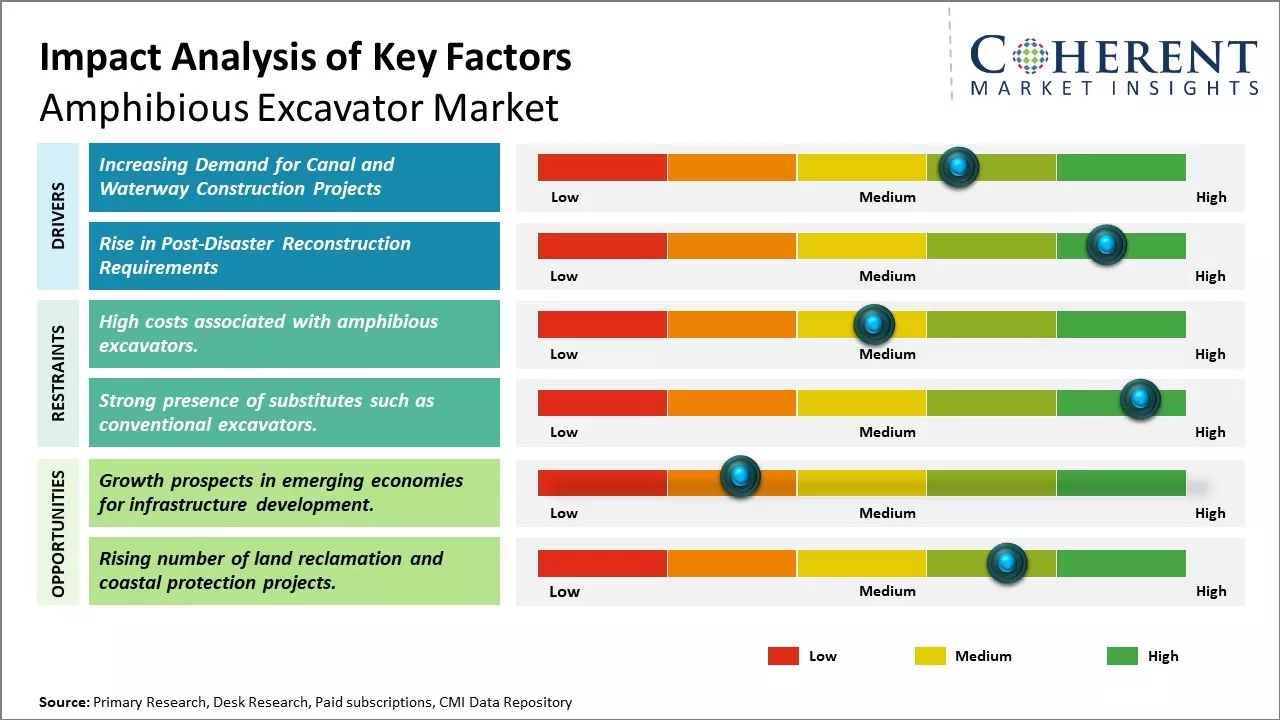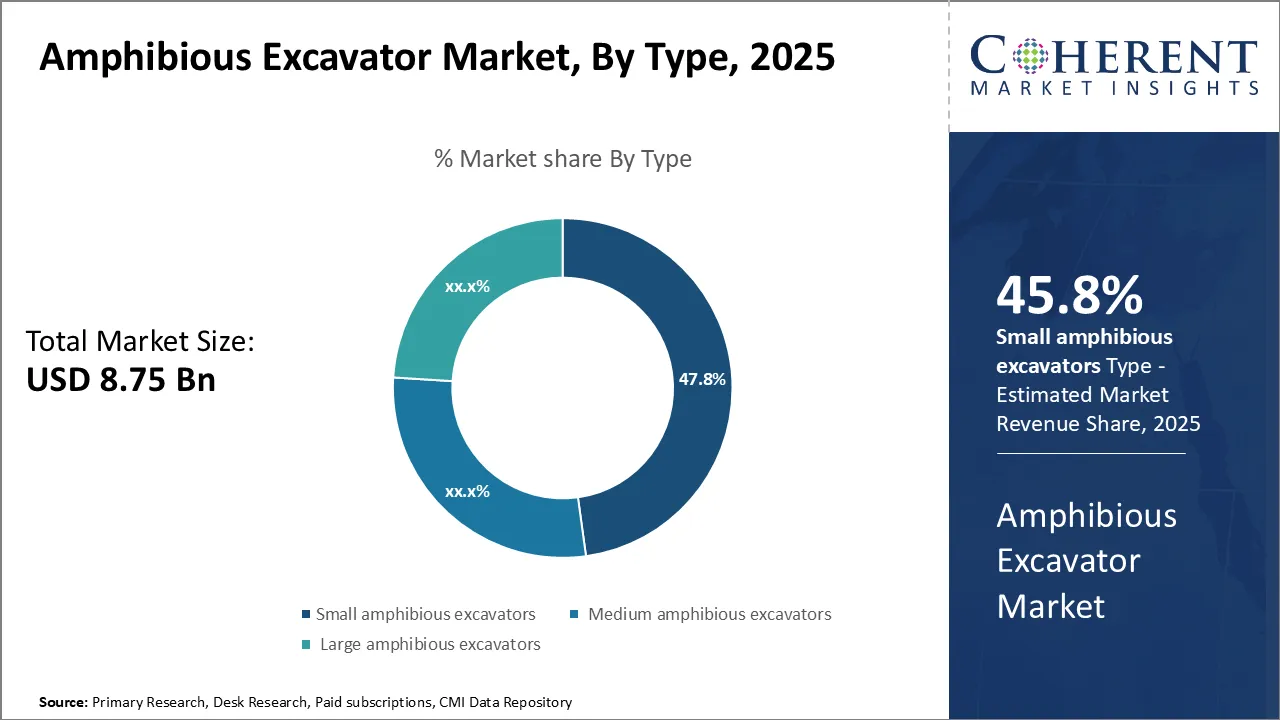Amphibious Excavator Market Size and Forecast – 2025-2032
The amphibious excavator market is estimated to be valued at USD 8.75 Bn in 2025 and is expected to reach USD 19.35 Bn by 2032, growing at a compound annual growth rate (CAGR) of 12.0% from 2025 to 2032.

To learn more about this report, Download Free Sample
Key Takeaways:
- Based on Type, Small Amphibious Excavators contributed the highest share of 45.8% in 2025 due to their versatility and suitability for various small-scale construction projects.
- Based on the Application segment, Dredging dominates the overall amphibious excavator market with an estimated share of 31.9% in 2025, owing to its extensive use in waterway maintenance and land reclamation projects.
- Based on Region, North America led the overall amphibious excavator market growth with a share of 37.9% in 2025 due to vibrant construction and infrastructure development activities across the United States and Canada.
Market Overview
The growing infrastructure development activities such as construction of dams, bridges, and land reclamation works especially in emerging economies will drive the demand for amphibious excavators. Additionally, the increasing demand for multifunctional equipment that can work on land and water will also support market growth. Wide applications in utility sector construction, agriculture, mining, and forestry operations will further contribute to the consumption of amphibious excavators between 2025 and 2032. However, high production and maintenance costs of amphibious excavators may hinder the market growth to some extent over the forecast period.
Current Events and Their Impact on the Amphibious Excavator Market
|
Current Events |
Description and its impact |
|
Infrastructure Development Initiatives in Emerging Economies |
|
|
Climate Change Adaptation Measures |
|
|
Technological Advancements |
|
|
Resource Extraction Pressures |
|
|
Geopolitical Conflicts |
|
Uncover macros and micros vetted on 75+ parameters: Get instant access to report
Amphibious Excavator Market Insights By, Type- Small amphibious excavators are driving the highest share in the type segment
The market prediction for 2025 indicates small amphibious excavators will control 45.8% of the sector through their specialized functions in combination with their compact design. Their weight of maximum 10 tons allows them to reach restricted locations and unsteady ground which remain inaccessible to heavy machinery. These machines remain affordable for residential along with infrastructure development which has led to more contractors choosing them in short-term rental services.
The Jamaican purchase of CAT Amphibious Excavator serves as an important illustration of this market segment with a total cost of $82.89 million. This amphibious equipment improves water flow through both Upper and Lower Morass of St. Elizabeth while serving more than 20 communities of the region due to increased infrastructure project interest in small amphibious excavators.
Amphibious Excavator Market Insights By, Applications- Dredging drives largest share in the application segment
The dredging segment of amphibious excavators will dominate the market reaching 31.9% of all sales in 2025. The market for dredging requires amphibious excavators because they demonstrate high operational efficiency across land-based and water-based applications. These machines can traverse soft terrain due to their track system and underwater capabilities from their hull configuration thus performing efficiently in water maintenance tasks. The rising number of global water management projects together with river restoration projects and flood protection initiatives continue to increase the demand for dredging equipment particularly in developing nations. Port desilting operations and water hyacinth removal activities along with other periodic tasks increase the overall market demand for this equipment.
Shenzhen's Maozhou River received operational assistance from amphibious excavators with cutter suction dredgers for river cleaning which improved both water flow and ecological vitality. The important environmental role that amphibious excavators play for projects dedicated to environmental enhancement stands clearly demonstrated.
Regional Insights

To learn more about this report, Download Free Sample
North America Amphibious Excavators Market Trends
The North American region takes the top position in the amphibious excavators market and is projected to hold 37.9% market share by 2025. Major infrastructure projects in North America including roadworks and tunnel constructions drive the market growth because amphibious excavators are necessary for these water-adjacent operations. The market development in the region receives additional support from local domestic manufacturers like Caterpillar and Case as well as a fully developed rental services industry with transparent prices. In March 2024, Maryland Environmental Service revealed that it is utilizing a Volvo EC300E amphibious excavator to aid in the restoration of Poplar Island, a remote island habitat in the Chesapeake Bay that was previously in decline.
Asia Pacific Amphibious Excavators Market Trends
The Asia Pacific region demonstrates fast market expansion in amphibious excavators because Chinese, Indian and Singaporean authorities invest in coastal construction activities within urban development projects. Amphibious excavators prove best in situations where ports and roads need to operate near water locations since they offer superior operational efficiency. Komatsu introduced its electric amphibious dozer in 2025. Electrical dozers feature ICT systems for remote control operations which help to solve workforce deficiencies. Testing results showed these machines were ideal for aquatic construction work since they proved their effectiveness in such conditions. The region’s sustainability goal matches this approach to create residential and disaster prevention developments as well as renewable energy initiatives like seagrass bed construction. The innovative efforts of Komatsu showcase the sector’s dedication to develop efficient solutions which promote sustainability and economic growth throughout Asia Pacific. These factors are thereby escalating the amphibious excavators market growth.
Nigeria Amphibious Excavators Market Trends
Two customized amphibious excavators receive their commission from the Federal Government of Nigeria for performing flood recovery work while cleaning up the environment. These amphibious machines operate in wetlands along with riverbeds and flood-hit zones since traditional excavators prove useless there. The machines possess the functions to dredge while assisting with disaster recovery work and protecting the environment and also eliminating harmful plant growth such as typha grass. The Minister of Water Resources indicated that water storage decreases at the Hadejia Barrage and Kanya River reservoirs have triggered silt accumulation along with typha grass growth that impedes irrigation canal water flow. The water flow through Kano River and Hadejia Valley irrigation schemes has been obstructed because 80% of main irrigation canals and distribution channels are blocked. The Jigawa State Government together with the federal initiative maintains two CAT 320 model amphibious excavators for aiding operations across Guri Town.
United Arab Emirates Amphibious Excavators Market Trends
The UAE market has received marine construction-specific amphibious excavators through a partnership between Al Marwan Heavy Machinery and Kobelco. The specially modified excavators serve best for port development together with offshore engineering projects and land transformation activities. The Kobelco SK380 Amphibious Long Boom Excavator operated at the Ajman Corniche project to efficiently achieve coastal protection and shoreline development. These construction projects benefit from the amphibious excavators which function with effectiveness in aquatic environments thus delivering peak performance across marine and waterfront development tasks. The agreement reflects increasing market needs for flexible and advanced equipment within the infrastructure development sector of the UAE.
Pricing Analysis of Amphibious Excavators
- Small Excavators (<20 Tons)
- Price Range: $150,000–$300,000
- Use Cases: These smaller excavators are ideal for tasks such as dredging in confined water bodies and conducting environmental restoration projects in shallow waters.
- Examples:
- Atlas Copco’s 8-ton Models: These compact machines are specifically designed for operations in shallow-water areas, offering maneuverability and efficiency in restricted spaces. Their price range reflects their smaller size and specialized design for these niche tasks.
These smaller excavators offer an affordable entry point for projects involving more accessible or less demanding environments.
- Medium Excavators (20–35 Tons)
- Dominant Segment: This segment held a significant 55.24% market share in 2023, showing its importance in both the construction and environmental sectors.
- Price Range: $350,000–$600,000
- Key Brands:
- Caterpillar 324FL: Priced at approximately $550,000, this model is optimized for wetland construction, providing excellent balance between power and fuel efficiency. The Caterpillar 324FL is widely used for marshland restoration, flood control, and large-scale excavation projects in wetland areas.
- Hitachi ZX210-5A: This hybrid engine model, priced around $485,000, offers improved fuel efficiency, making it a cost-effective choice for long-term environmental projects. It is suitable for a variety of medium-scale excavation tasks, including dredging and shoreline restoration.
Medium-sized excavators represent the sweet spot for most environmental and construction projects, combining cost-effectiveness with higher capacity and operational flexibility. They are the most popular choice for projects that require more power and versatility than smaller machines can provide.
- Large Excavators (>35 Tons)
- Price Range: $700,000–$1.2 Million
- Applications: Large excavators are used for heavy-duty tasks such as offshore oil & gas operations, major flood control projects, and large-scale environmental restoration efforts. Their size and capabilities make them suitable for the toughest and most demanding tasks in harsh and remote environments.
- Example:
- SANY SY750H: This 45-ton model, priced around $950,000, offers up to 30% higher sediment capacity compared to smaller models, making it ideal for larger dredging and excavation operations. With its robust design, the SANY SY750H is a powerful choice for handling large-scale projects that require the movement of massive amounts of sediment and debris.
Large excavators are designed for the highest-demand applications, offering substantial power and capacity to manage larger operations, often in offshore and flood-control sectors. The higher price tag reflects their advanced features, including increased capacity, improved durability, and specialized equipment that allows for operations in deep or complex environments.
End-user Feedback and Unmet Needs
- Performance & Reliability: Enhanced stability along with superior performance through all terrains is required for amphibious excavators used with swamps and shallow waters and wetlands by operators. Extremely unpredictable operating conditions and harsh environments create difficulties for contemporary machine models.
- Ease of Operation & Versatility: The construction and disaster management sectors require excavators with simple operation and multi-capability to seamlessly perform tasks in water and land environments despite their critical time-sensitive demands.
- Cost-effectiveness: The expensive cost of high-performance amphibious excavators restricts their amphibious excavator market penetration particularly in developing areas. The market requires accessible and durable yet multifunctional amphibious excavators because they would increase their utility in mining sectors along with agricultural applications and infrastructure construction.
Amphibious Excavator Market Trend
Increasing Demand for Canal and Waterway Construction Projects
Rapid urbanization is driving the need for new infrastructure, with waterways playing a critical role alongside roads and railways. Many countries are expanding and deepening canals to ease congestion and support larger vessels. Amphibious excavators, capable of operating on land and underwater up to 12 meters deep, have become essential for such projects. Their versatility for dredging, pipeline laying, and retaining wall construction is increasingly valued. For instance, in May 2024, in India, the Vadodara Municipal Corporation (VMC) planned to deploy an amphibious excavator to clean stormwater drains inaccessible to traditional machines, enhancing the city’s flood resilience.
Market Concentration and Competitive Landscape

To learn more about this report, Download Free Sample
Rise in Post-disaster Reconstruction Requirements
Extreme weather events together with seismic activities lead to rising numbers of intense natural disasters across the world. The resulting extensive damage because of natural disasters to infrastructure and property calls for extensive post-disaster reconstruction projects. Protection works receive renovation as top priority in regions where rivers meet the coast and experience flooding. Such post-disaster situations require amphibious excavators to become essential due to their dual capabilities of operating on land and water surfaces. The amphibious character enables machines to complete excavation together with debris elimination whenever flood waters surpass the fluvial zone. The equipment operates on both land surfaces as well as under water to enhance the speed of rehabilitation tasks. In August 2023, Japan-created amphibious excavator operated as a floating machine during river development operations in Las Piñas City to boost floodwater capability alongside disaster risk mitigation. The combination between large buckets and hydraulic tools in amphibious excavators enables high productivity. These factors are further positively influencing the amphibious excavator market forecast.
Amphibious Excavator Market Challenges: High costs associated with amphibious excavators
High standards in exhaust emissions compel manufacturers to commit major funds for meeting strict regulatory requirements. The excessive cost of amphibious excavators prevents numerous potential consumers from purchasing them. Beyond initial costs amphibious excavators become increasingly expensive because of operator training needs and required maintenance services. The necessity for amphibious machine operation dwindles significantly in areas which have seasons leading to decreased amphibious excavator market demand.
Amphibious Excavator Market Opportunities: Growth prospects in emerging economies for infrastructure development
Various infrastructure development initiatives that involve bodies of water are expanding across the world due to underwater asset servicing needs and land reclamation requirements. The essentiality of amphibious excavators appears because they offer land and water transitioning abilities for the tasks. The USD 110 million amphibious excavator serves farmers in Tapakuma Village Guyana to enhance drainage infrastructure and irrigation systems for agricultural purposes. The purchase of these devices represents ongoing infrastructure modernization along with expanding market requirements for advanced equipment in water-based undertakings. The number of amphibious excavators on the market will continue to rise due to increasing environmental challenges and urbanization trends. These machines represent essential tools for modern infrastructure projects which operate in zones affected by flooding or submerged by water. World, further accelerating the amphibious excavator market share.
Market Report Scope
Amphibious Excavator Market Report Coverage
| Report Coverage | Details | ||
|---|---|---|---|
| Base Year: | 2024 | Market Size in 2025: | USD 8.75 Bn |
| Historical Data for: | 2020 To 2024 | Forecast Period: | 2025 To 2032 |
| Forecast Period 2025 to 2032 CAGR: | 12.0% | 2032 Value Projection: | USD 19.35 Bn |
| Geographies covered: |
|
||
| Segments covered: |
|
||
| Companies covered: |
EIK International Corporation, Ultratrex Machinery SDN. BHD., Wetland Equipment Company, Hitachi Construction Machinery Co., Ltd. (HCM), Gulf Coast Specialty Energy Services (GCSES), Remu Oy, TSBC Engineering SDN BHD, Doosan Infracore’s Construction Equipment, Marsh Buggies Incorporated (MBI), Waterking BV, MBI Marsh Equipment, Sany Chemical, LT Construction Mining Machinery, Caterpillar, FROGCO Amphibious Equipment Inc., Hyundai, and SUNTON |
||
| Growth Drivers: |
|
||
| Restraints & Challenges: |
|
||
Uncover macros and micros vetted on 75+ parameters: Get instant access to report
Analyst Opinion (Expert opinion)
- The UK has introduced a 64.17% anti-dumping duty on mid-size Chinese excavators. This has led to a notable shift in Chinese export strategies, redirecting sales to Southeast Asia and Africa. Consequently, European markets are now seeing a surge in demand for local players like JCB and Volvo, which have benefitted from the reduced competition in the mid-sized segment. This shift could reinforce Europe's position as a leader in amphibious excavator manufacturing while creating a gap in Southeast Asian markets that may be filled by lower-cost Chinese units.
- The increasing adoption of energy-efficient hydraulic systems is accelerating the transition to electric amphibious excavators, making them more viable for environmental restoration projects. Danfoss’ Dextreme Max, a cutting-edge hydraulic system, is reducing battery needs by 33%. This breakthrough is significant because it reduces the overall cost of electrification, allowing electric amphibious excavators to become more financially feasible for projects like floodplain restoration and wetland management by 2026. With electrification being a core focus of EU Stage V emission regulations, these innovations will likely increase demand for energy-efficient solutions.
- In addition to this, India’s Gati Shakti initiative, a USD 1.3 trillion infrastructure program, is expected to drive a 11.9% CAGR in amphibious excavator deployments. The project focuses on improving port connectivity and hydropower projects in the Himalayan region. Amphibious excavators will be pivotal for these large-scale initiatives, particularly for dredging and sediment management tasks.
Key Developments in Amphibious Excavator Market
- In March 2025, Waterking, a Dutch dredging equipment manufacturer, unveiled the world's first electric amphibious dredging set. In partnership with Staad Groep, they created the 35-tonne electric amphibious excavator, the WK 350 NG-E, with Damen supplying the E-DOP 150 to complete the emission-free system.
- In September 2023, the Ranchi Municipal Corporation (RMC) acquired a floating excavator, or amphibious excavator, to remove silt from the historic Ranchi Lake, which has experienced significant degradation in both its storage capacity and aquatic health over the years.
- In January 2023, the city of Las Piñas launched an amphibious excavator in partnership with the Department of Public Works and Highways (DPWH), the Japan International Cooperation Agency (JICA) and the Villar Sipag Foundation. The machine will remove accumulated garbage and silt from the narrow Las Piñas river to help improve its capacity to withstand floods.
- In June 2024, the National Drainage and Irrigation Authority (NDIA) procured the amphibious excavator for approximately $110 million and will use it to carry out critical drainage works across the region.
Market Segmentation
- By Type
- Small amphibious excavators
- Medium amphibious excavators
- Large amphibious excavators
- By Application
- Dredging
- Oil and gas pipeline installation
- Landscaping
- Highway construction
- Others
- By Regional
- North America
- Latin America
- Europe
- Asia Pacific
- Middle East
- Africa
- Key Players
- EIK International Corporation
- Ultratrex Machinery SDN. BHD.
- Wetland Equipment Company
- Hitachi Construction Machinery Co., Ltd. (HCM)
- Gulf Coast Specialty Energy Services (GCSES)
- Remu Oy
- TSBC Engineering SDN BHD
- Doosan Infracore’s Construction Equipment
- Marsh Buggies Incorporated (MBI)
- Waterking BV
- MBI Marsh Equipment
- Sany Chemical
- LT Construction Mining Machinery
- Caterpillar
- FROGCO Amphibious Equipment Inc.
- Hyundai
- SUNTON
Sources
Primary Research Interviews from the following stakeholders:
Stakeholders:
- Interviews with construction equipment manufacturers, civil engineers, dredging contractors, wetland restoration experts, and infrastructure project managers.
- Specific stakeholders: Marine construction specialists, flood management authorities, mining operators, environmental engineers, and equipment rental company executives.
Databases:
- ScienceDirect
- ResearchGate
- Others
Magazines:
- Construction Equipment Magazine
- International Dredging Review
- Equipment World
- Heavy Equipment Guide
Journals:
- Journal of Hydraulic Engineering
- Journal of Construction Engineering and Management
- Journal of Waterway, Port, Coastal, and Ocean Engineering
- Journal of Environmental Management
Newspapers:
- The New York Times
- The Guardian
- The Wall Street Journal
- Financial Times
- The Washington Post
Associations:
- Association of Equipment Manufacturers (AEM)
- Dredging Contractors of America (DCA)
- International Association of Dredging Companies (IADC)
- American Society of Civil Engineers (ASCE)
- Wetlands International
Public Domain Sources:
- U.S. Army Corps of Engineers (USACE)
- United Nations Environment Programme (UNEP)
- World Bank Infrastructure Reports
- European Environment Agency (EEA)
Proprietary Elements:
- CMI Data Analytics Tool, and Proprietary CMI Existing Repository of information for the last 8 years
Share
Share
About Author
Ramprasad Bhute is a Senior Research Consultant with over 6 years of experience in market research and business consulting. He manages consulting and market research projects centered on go-to-market strategy, opportunity analysis, competitive landscape, and market size estimation and forecasting. He also advises clients on identifying and targeting absolute opportunities to penetrate untapped markets.
Missing comfort of reading report in your local language? Find your preferred language :
Transform your Strategy with Exclusive Trending Reports :
Frequently Asked Questions
EXISTING CLIENTELE
Joining thousands of companies around the world committed to making the Excellent Business Solutions.
View All Our Clients

